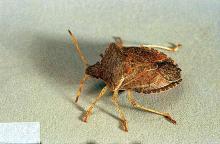Includes
Plant bugs (Lygus hesperus and L. lineolaris)
Stink bugs including Consperse stink bug (Euschistus conspersus)
See also:
Brown Marmorated Stink Bug: An Emerging Threat to Pacific Northwest Agriculture
Pest description and crop damage Adult plant bugs are flattened, semi-oval insects 0.15 to 0.20 inch in length. They can be yellow, green, and dark brown to black with a conspicuous yellow or pale green triangle on the back. Adult stink bugs have a flattened shield shape. Length ranges from 0.5 to 0.7 inch and color from gray to brown to green. Stink bugs are noisy fliers, with long, piercing-sucking mouthparts.
Feeding damage causes dimpling and sunken spots on young fruit that can deform the shape of the fruit by harvest (often referred to as cat-facing). Internal fruit damage appears as white corky areas under the surface of the fruit. Feeding may deform or kill buds and shoots. These bugs have an extremely wide host range that includes field and vegetable crops, hay crops, natural vegetation in uncultivated land, and weeds in adjacent areas. These pests do not reproduce on tree crops but invade from outside hosts.
Biology and life history Adults overwinter in groundcover. Early in the season, they feed on weeds in groundcover and adjacent fields. Later in the summer as alternative hosts dry up, these bugs may move into the canopy of fruit trees.
Pest monitoring Periodically scout the canopy of fruit trees for the presence of adult plant and stink bugs, particularly in trees with a history of bug damage to the fruit. Critical times to scout are when the adjacent weed hosts are drying up or nearby host crops are being harvested. The brown marmorated stink bug can be monitored with commercial lure-baited pyramid traps.
Management-cultural control
When possible, do not plant apricot trees adjacent to hay fields, weedy lots, or uncultivated land. Proper weed management early in the season can reduce the attractiveness of an orchard to these pests. DO NOT mow the orchard floor within two weeks of fruit harvest as any bug infestation in the ground cover will move to the tree canopy.
Management-chemical control
Spray applications, primarily pyrethroid products, target adult bugs. These products work best as spray residues that intercept plant and stink bugs as they move between alternative host sources and fruit trees.
Management-chemical control: HOME USE
- azadirachtin (neem oil)-Some formulations are OMRI-listed for organic use.
- carbaryl-Highly toxic to bees.
- gamma-cyhalothrin-Highly toxic to bees.
- insecticidal soap-May require several applications. Some formulations are OMRI-listed for organic use.
- kaolin-When sprayed on leaves, trunks, and fruit, kaolin acts as a repellant to some insects. Some formulations are OMRI-listed for organic use.
- lambda-cyhalothrin-Highly toxic to bees.
- pyrethrins-Highly toxic to bees. Some formulations are OMRI-listed for organic use.
- zeta-cypermethrin-Highly toxic to bees.
Management-chemical control: COMMERCIAL USE
Prebloom/Growing-season sprays
- esfenvalerate (Asana XL) at 2 to 5.8 fl oz/100 gal water of dilute spray (4.8 to 14.5 fl oz/A of concentrate). REI 12 hr. PHI 14 days. May disrupt beneficial mite populations. Extremely toxic to fish and aquatic invertebrates; avoid spray drift and runoff to surface waters. Do not spray more than 0.375 lb/A per season, with no more than 0.3 lb/A between bloom and harvest.
- lambda-cyhalothrin (Warrior II with Zeon Technology) at 1.28 to 2.56 fl oz/A (0.02 to 0.04 lb/A). REI 24 hr. PHI 14 days. May disrupt beneficial mite populations. Extremely toxic to fish; avoid spray drift and surface runoff.


